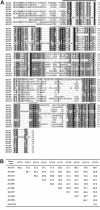Molecular analyses of the Arabidopsis TUBBY-like protein gene family
- PMID: 15064372
- PMCID: PMC419833
- DOI: 10.1104/pp.103.037820
Molecular analyses of the Arabidopsis TUBBY-like protein gene family
Abstract
In mammals, TUBBY-like proteins play an important role in maintenance and function of neuronal cells during postdifferentiation and development. We have identified a TUBBY-like protein gene family with 11 members in Arabidopsis, named AtTLP1-11. Although seven of the AtTLP genes are located on chromosome I, no local tandem repeats or gene clusters are identified. Except for AtTLP4, reverse transcription-PCR analysis indicates that all these genes are expressed in various organs in 6-week-old Arabidopsis. AtTLP1, 2, 3, 6, 7, 9, 10, and 11 are expressed ubiquitously in all the organs tested, but the expression of AtTLP5 and 8 shows dramatic organ specificity. These 11 family members share 30% to 80% amino acid similarities across their conserved C-terminal tubby domains. Unlike the highly diverse N-terminal region of animal TUBBY-like proteins, all AtTLP members except AtTLP8 contain a conserved F-box domain (51-57 residues). The interaction between AtTLP9 and ASK1 (Arabidopsis Skp1-like 1) is confirmed via yeast (Saccharomyces cerevisiae) two-hybrid assays. Abscisic acid (ABA)-insensitive phenotypes are observed for two independent AtTLP9 mutant lines, whereas transgenic plants overexpressing AtTLP9 are hypersensitive to ABA. These results suggest that AtTLP9 may participate in the ABA signaling pathway.
Figures








Similar articles
-
Characterization of Arabidopsis Tubby-like proteins and redundant function of AtTLP3 and AtTLP9 in plant response to ABA and osmotic stress.Plant Mol Biol. 2014 Nov;86(4-5):471-83. doi: 10.1007/s11103-014-0241-6. Epub 2014 Aug 29. Plant Mol Biol. 2014. PMID: 25168737
-
F-box gene FOA2 regulates GA- and ABA- mediated seed germination in Arabidopsis.Sci China Life Sci. 2016 Nov;59(11):1192-1194. doi: 10.1007/s11427-016-0098-3. Epub 2016 Sep 9. Sci China Life Sci. 2016. PMID: 27612866 No abstract available.
-
The Arabidopsis thaliana ABSCISIC ACID-INSENSITIVE8 encodes a novel protein mediating abscisic acid and sugar responses essential for growth.Plant Cell. 2004 Feb;16(2):406-21. doi: 10.1105/tpc.018077. Epub 2004 Jan 23. Plant Cell. 2004. PMID: 14742875 Free PMC article.
-
Abscisic acid signaling in seeds and seedlings.Plant Cell. 2002;14 Suppl(Suppl):S15-45. doi: 10.1105/tpc.010441. Plant Cell. 2002. PMID: 12045268 Free PMC article. Review. No abstract available.
-
Regulation of abscisic acid biosynthesis.Plant Physiol. 2003 Sep;133(1):29-36. doi: 10.1104/pp.103.025395. Plant Physiol. 2003. PMID: 12970472 Free PMC article. Review. No abstract available.
Cited by
-
Genome-wide association mapping for resistance to leaf, stem, and yellow rusts of common wheat under field conditions of South Kazakhstan.PeerJ. 2020 Aug 31;8:e9820. doi: 10.7717/peerj.9820. eCollection 2020. PeerJ. 2020. PMID: 32944423 Free PMC article.
-
Genome sequence of the palaeopolyploid soybean.Nature. 2010 Jan 14;463(7278):178-83. doi: 10.1038/nature08670. Nature. 2010. PMID: 20075913
-
Tubby-like Protein 2 regulates homogalacturonan biosynthesis in Arabidopsis seed coat mucilage.Plant Mol Biol. 2019 Mar;99(4-5):421-436. doi: 10.1007/s11103-019-00827-9. Epub 2019 Feb 1. Plant Mol Biol. 2019. PMID: 30707395
-
Identification, evolution and expression analyses of whole genome-wide TLP gene family in Brassica napus.BMC Genomics. 2020 Mar 30;21(1):264. doi: 10.1186/s12864-020-6678-x. BMC Genomics. 2020. PMID: 32228446 Free PMC article.
-
Tubby-like proteins (TLPs) transcription factor in different regulatory mechanism in plants: a review.Plant Mol Biol. 2022 Dec;110(6):455-468. doi: 10.1007/s11103-022-01301-9. Epub 2022 Oct 18. Plant Mol Biol. 2022. PMID: 36255595 Review.
References
-
- Bai C, Sen P, Hofmann K, Ma L, Goebl M, Harper JW, Elledge SJ (1996) SKP1 connects cell cycle regulators to the ubiquitin proteolysis machinery through a novel motif, the F-box. Cell 86: 263–274 - PubMed
-
- Boggon TJ, Shan WS, Santagata S, Myers SC, Shapiro SL (1999) Implication of tubby proteins as transcription factors by structure-based functional analysis. Science 286: 2119–2125 - PubMed
-
- Clough SJ, Bent AF (1998) Floral dip: a simplified method for Agrobacterium-mediated transformation of Arabidopsis thaliana. Plant J 16: 735–743 - PubMed
-
- Coleman DL, Eicher EM (1990) Fat (fat) and tubby (tub): two autosomal recessive mutations causing obesity syndromes in the mouse. J Hered 81: 424–427 - PubMed
Publication types
MeSH terms
Substances
Associated data
- Actions
- Actions
- Actions
- Actions
- Actions
- Actions
- Actions
- Actions
- Actions
- Actions
LinkOut - more resources
Full Text Sources
Other Literature Sources
Molecular Biology Databases
Miscellaneous

